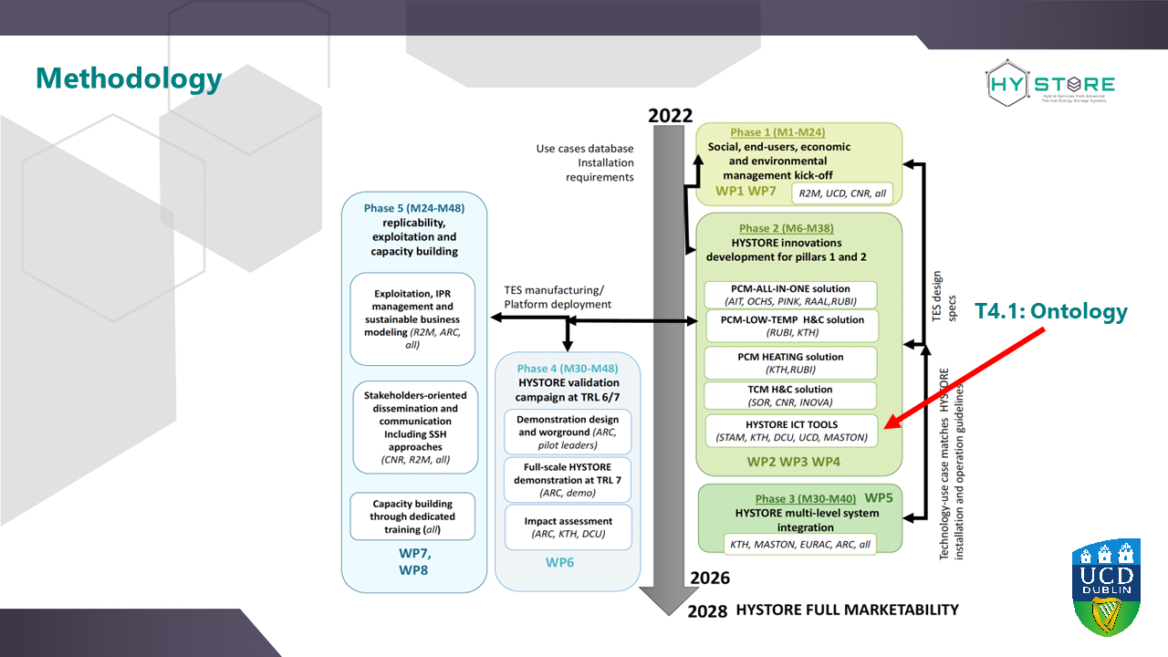Hystore presents Eleni Mangina : Hystore expert on Ontology
Ontology practices to support Hystore research. Dr Mangina describes
What is ontology
Ontology, in the context of information science and artificial intelligence, is a formal representation of a set of concepts within a domain and the relationships between those concepts. It is used to model domain knowledge and can be employed for various purposes such as data integration, information retrieval, and knowledge management. Ontologies are crucial in AI for enabling shared understanding of a domain, facilitating interoperability between systems, and supporting reasoning about the entities within that domain. They play a significant role in fields such as semantic web, natural language processing, and knowledge representation.
Eleni Mangina: ontolgy and AI expert
Dr. Eleni Mangina is the expert in Hystore of the Ontology results. Dr.Eleni drove to Ontology thanks to her expertise in AI and its applications. In fact, she is a tenured Professor at University College Dublin and Vice Principal (International) for the College of Science and she earned her PhD in Electronic and Electrical Engineering from the University of Strathclyde, focusing on Agent-based applications for power systems. With over 20 years of experience in National, EU, and International funded projects, she has authored more than 300 peer-reviewed articles and actively contributes to IEEE Standards, influencing the ethical and effective implementation of AI technologies.

Hystore’s mission
The Hystore Project Is a scientific project that aims to develop new technologies that will improve Thermal Energy Storage (TES) Systems based on the combination of cutting-edge technology components: ALL-IN-ONE Phase Change Material (PCM) solution, LOW-TEMP PCM HEATING&COOLING solution, PCM HEATING solution and Thermochemical Material (TCM) HEATING&COOLING solution

Ontology for Hystore
The ontology development involves creating structured representations of knowledge within the TES domains. These representations help researchers better understand concepts, relationships, and entities within their field of study. We plan to explore the Domain-specific ontology for TES: Creating ontologies tailored to specific domains such as Thermal Energy storage to facilitate data integration, analysis, and knowledge discovery within the energy field.
Hystore outcome: ontology- driven model-based storage service
In Hystore, we aim to deliver the ICT tools that will streamline the deployment and integration within real operational scenarios of the HYSTORE TES Solutions. One of the key objectives is to develop an ontology- driven model-based storage service. The aim is to leverage and rationalize existing energy system and smart appliances ontologies (e.g. SAREF) to define a structured model-based energy storage service characterization to be exploited within the project.
Ontology activities
The task will revolve around a set of activities, namely.
• Assessment of TES systems and tech aspects,
• Ontologies assessment and analysis (This is where we are now)
• Model-based energy storage service design,
• Service development and integration and using IoT-based ontology for a comprehensive storage service design.
The most important innovation in HYSTORE related to Ontology
The HYSTORE TES Ontology will introduce several innovations in ontology-driven, model-based storage service integration, set to launch in June 2025. These include:
• Semantic Interoperability: Creating ontologies that enable seamless data exchange between different systems and datasets.
• Ontology Alignment and Integration: Developing tools to align and integrate
ontologies from various sources for cross-disciplinary research.
• Ontology-Driven Data Analytics: Using ontologies to structure and analyze large data sets, helping researchers uncover meaningful insights.
• Ontology Evolution and Maintenance: Implementing strategies for updating and maintaining ontologies to keep up with evolving knowledge and requirements.
How we will create a TES Ontology
To create the model, we will use and extend the SAREF ontology for energy storage systems to describe data exchange through communication protocols, data processing, and system integration for optimized energy management. Furthermore, we will integrate tools and algorithms developed within the project outcomes – “Modeling of storage system including PCM/TCM storage, auxilliaries and low level controller” and “Development of low-level monitoring algorithms”. Sensor dictionary will be developed in this task for energy storage services and their integration in buildings and grid, such as AI and rule-based reasoning for TES systems control and operation. This will ensure that there is an effective communication interface and TES variety descriptions over the entire system using IoT and cloud services.
How will this be created?
SAREF (Smart Appliances REFerence) ontology involves adding new concepts, properties, and relationships to better represent the domain of smart appliances and related IoT (Internet of Things) devices.
We plan to extend SAREF with SAREF4TES:
Domain Specification: We will extend SAREF to cover TES systems, incorporating concepts relevant to energy storage.
Analyse existing concepts: Review and understand the current SAREF ontology to identify gaps related to TES.
Identify new concepts: Identify and define new TES-specific concepts, such as types of devices, sensors, actuators, and environmental factors.
Properties and relationships: Define new properties and relationships for TES concepts, ensuring they integrate seamlessly with existing SAREF concepts.
Reuse existing concepts: Where possible, reuse existing SAREF concepts to maintain interoperability.
Follow ontology engineering best practices: Use standardized ontology modeling languages such as RDF (Resource Description Framework) and OWL (Web Ontology Language) to define SAREF4TES extension and adhering to best practices for clarity, consistency, and modularity.
Document SAREF4TES: Thoroughly document the new concepts, properties, and relationships, including definitions, usage guidelines, and examples to help others use extensions effectively.
Consider community feedback: Share the extended ontology with the SAREF community and standards organizations like CEN/CENELEC for feedback and alignment.
Version management: Maintain version control for SAREF4TES to track changes and updates over time. This helps ensure traceability and reproducibility of our work.
By following these steps, we will effectively extend the SAREF ontology to address specific requirements and use cases within TES domain while maintaining compatibility and interoperability with the original ontology.